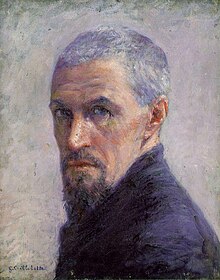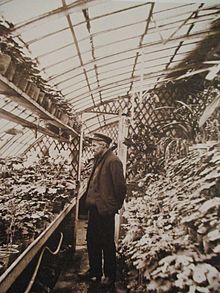Gustave Caillebotte
Gustave Caillebotte (born August 19, 1848 in Paris , † February 21, 1894 in Gennevilliers , Hauts-de-Seine department ) was a French impressionist painter , art collector, patron and boat builder .
Life
family
Pierre Caillebotte, the artist's great-grandfather, came from the town of Ger in Normandy. After his wedding he moved to Domfront , where he ran a cloth trade. The business was initially taken over by his son Pierre Caillebotte (junior) and later by his grandson Martial Caillebotte (1799–1874), the father of Gustave Caillebotte. He settled in Paris in 1830 and supplied the French military with beds and bed linen and ran a large laundry - a lucrative business that made the family prosperous. From 1861 the father also worked as a judge at the commercial court of the Seine department and was appointed Knight of the Legion of Honor in the same year .
Martial Caillebotte was married three times. The first marriage with Adèle Zoé Boissière had two children: the daughter Léonie, who died at the age of six, and the son Alfred (1819-1894), who later served as pastor at the Paris church Notre-Dame-de-Lorette worked. After his second wife Eugénie le Masquerier died in childbed, Martial Caillebotte married in third marriage on September 14, 1847 Céleste Daufresne (1819-1878), the daughter of a customs officer from Lisieux . From this marriage, Gustave Caillebotte, who was born on August 19, 1848, was the eldest son, followed by the brothers René (1851–1876) and Martial (1853–1910). The family initially lived on Rue du Faubourg-Saint-Denis, where the family business was also located. In addition, the father bought an estate in Puisieux in 1852 and had a comfortable country house built in Yerres in 1860 . In Paris, the family moved into a newly built Hôtel particulier on the corner of Rue Miromesnil and Rue de Lisbonne in 1868 .
Youth and education

Gustave Caillebotte attended the Lycée Louis-le-Grand boarding school in Vanves from 1857 to 1862 . He has been drawing since he was twelve. It is not known where he continued his schooling. He then studied law and graduated on July 6, 1870 with the license en droit . Only a few days later the Franco-Prussian War began and Caillebotte was drafted into the Garde nationale mobile de la Seine . In this unit he served nine months until he was released on March 7, 1871. In the same year he toured Sweden and Norway with his brothers Alfred and René.
A trip to Italy followed in 1872, which Caillebotte took with his father. Here he visited the painter Giuseppe de Nittis in Naples and he painted paintings such as Street near Naples . This picture is one of the artist's earliest known paintings and is clearly under the influence of de Nittis and already shows strict geometric lines that would later characterize his Parisian cityscapes. In the same year he took lessons from the painter Léon Bonnat in order to prepare for the entrance exam to the École des Beaux-Arts . There he is registered as a pupil of Jean-Léon Gérôme , Isidore Pils and Alexandre Cabanel in painting in 1873 , but only attending Adolphe Yvon's drawing class on March 18 of the same year is documented.
He inherited his father at the age of 25. On the inherited estate in Yerres , around 80 works were created by 1879. Financial independence made him an important supporter of the Impressionists .
Caillebotte met Edgar Degas , Claude Monet and Pierre-Auguste Renoir , whose style also influenced him in some areas. His landscape paintings are strongly based on Frédéric Bazille , while the portraits are more reminiscent of those of Degas. Initially, Caillebotte had started painting in the traditional style. Between 1875 and 1880 his style was similar to that of the Impressionists. In his pictures, life is reflected in the middle-class residential areas of Paris or in the country in summer.
patron
Caillebotte helped to finance and organize the first exhibitions of the Impressionists. At the same time he painted around 500 pictures himself and collected works of contemporary impressionist art. The artist bequeathed his collection to the French state on the condition that the pictures in the collection were not kept in a warehouse or given to a provincial museum, but rather exhibited in their entirety in the Louvre or the Musée du Luxembourg in Paris. Due to this condition, the state did not take over all, but only most of the pictures from the collection. Negotiations were conducted by Caillebotte's brother Martial and Pierre-Auguste Renoir .
The works accepted by the French state can now be seen as the Caillebotte Collection in the Musée d'Orsay in Paris . To be accepted by the State paintings belonged Moulin de la Galette , The Swing and female nude in the sunlight of Pierre-Auguste Renoir , Gare Saint-Lazare , Breakfast and Regatta at Argenteuil by Claude Monet , The balcony and Angélina by Edouard Manet , The Red Roofs by Camille Pissarro , L'Estaque by Paul Cézanne and some pastels by Edgar Degas .
Sailors and boat builders
In 1876, Caillebotte began sailing on the Seine near Paris . Soon afterwards he drove to the Norman coast every summer and participated in the regattas in Le Havre and Trouville . Le Yacht magazine reported numerous victories for Caillebotte.
Together with his brother Martial, Gustave became a member of the Paris sailing club Cercle de la Voile de Paris in 1876 . In 1880 Gustave Caillebotte became its vice-president and in 1881 the Caillebotte brothers bought a house near the sailing club. Caillebotte advocated both painting and sailing. In 1882 he began building boats himself and in 1885 founded a company called Chantiers Luce , where a total of 21 sailing yachts were built according to his designs. For the first time, he introduced external ballast to traditional French keelboats instead of the stone ballast bags previously placed in the hull. In 1889, Caillebotte also developed regatta boats with a uniform sail area of 30 square meters.
End of life
In the 1880s, Caillebotte retired to his country estate in Petit Gennevilliers . The place is on the banks of the Seine across from Argenteuil , where some of his Impressionist friends often worked. When Caillebotte died of a stroke at the age of forty-five in 1894, he was a recognized, if not undisputed, painter. Much of his work is in private hands. This may have contributed to the fact that he is less well known than other French painters of his time.
reception
The German writer Hartmut Lange made the painting Jeune homme à la fenêtre from 1875 the subject of his story The View from the Window , which was published in 2015 by Diogenes Verlag , Zurich, in the volume of short stories of the same name. It describes Caillebotte's painting, about which the protagonist Giselher Reinhardt says that there is a similar view from the room of his Berlin apartment with the window open. In the evening he even had the impression that, as in the painting by Caillebotte, instead of the cars crossing the square, he actually saw a few carriages.
Works (selection)
- The parquet grinder (Les raboteurs de parquet) , 1875
- Jeune homme à la fenêtre , 1875
- Street in Paris on a rainy day (Rue de Paris, temps de pluie) , 1877
- On the Europe Bridge (Le Pont de L'Europe) , 1877
- Snow-covered roofs (Vue de toits (Effet de neige)) , around 1878
- In the café (Dans un café) , 1880
- Man on the Balcony, Boulevard Haussmann (L'Homme au balcon, boulevard Haussmann) , 1880, sold in May 2000 at Christie's for $ 14,306,000.
- The Argenteuil Bridge and the Seine , around 1883–1885
literature
- Kirk Varnedoe : Gustave Caillebotte . Yale University Press, New Haven 1987, ISBN 0-300-08279-7 .
- Marie Berhaut : Gustave Caillebotte. Catalog raisonné des peintures et pastels . Wildenstein Institute, Paris 1994, ISBN 2-908063-09-3 .
- Anne Distel: Gustave Caillebotte: Urban impressionist . Abbeville Press, New York 1995, ISBN 0-7892-0041-4 .
- Anne-Birgitte Fonsmark: Across the water - Gustave Caillebotte . Exhibition catalog Kunsthalle Bremen , Hatje Cantz, Ostfildern 2008, ISBN 978-3-7757-2190-5 .
- Karin Sagner: Gustave Caillebotte. New perspectives on impressionism . Hirmer, Munich 2009, ISBN 978-3-7774-2161-2 .
- Ralph Gleis (ed.): Gustave Caillebotte: Painter and Patron of Impressionism , Munich: Hirmer 2019, ISBN 978-3-7774-3322-6 .
Exhibitions
- 2019: Gustav Caillebotte: Painter and Patron of Impressionism , Alte Nationalgalerie , Berlin
- 2012/2013: Gustave Caillebotte. An impressionist and photography , Kunsthalle Schirn , Frankfurt am Main
- 2011: Dans l'intimité des frères Caillebotte - Peintre et Photographe , Museé Jacquemart-André , Paris
- 2008: Across the Water: Gustave Caillebotte. An impressionist is rediscovered . Kunsthalle Bremen
Web links
- Literature by and about Gustave Caillebotte in the catalog of the German National Library
- Gustave Caillebotte on kunstaspekte.de
- Article about Gustave Caillebotte in Schirn Magazin
- Gustave Caillebotte at Google Arts & Culture
Individual evidence
- ↑ There is a close relationship between Caillebotte's work and de Nitti's painting Road from Naples to Brindisi , also made around 1872. See Anne Distel: Gustave Caillebotte , p. 32.
- ↑ Anne Distel suspects that Caillebotte only rarely attended the École des Beaux-Arts. See Anne Distel: Gustave Caillebotte , p. 312.
- ^ Gleis, Ralph (ed.): Gustave Caillebotte: painter and patron of impressionism . Hirmer, Munich 2019, ISBN 978-3-7774-3322-6 , pp. 120 ( gustavecaillebotteinberlin.de [accessed June 18, 2019]).
- ↑ Hartmut Lange: The view from the window . Diogenes Verlag, Zurich 2015, ISBN 978-3-257-06953-2 .
- ↑ Jan Drees: Unheimliche incendeen. In his fantastic stories, Hartmut Lange lets German past and present collide. In: freitag.de. August 26, 2015, accessed August 21, 2018 .
- ↑ Gustave Caillebotte. Retrieved June 2, 2019 .
- ↑ Dans l'intimité des frères Caillebotte. March 15, 2016, accessed June 2, 2019 (French).
| personal data | |
|---|---|
| SURNAME | Caillebotte, Gustave |
| BRIEF DESCRIPTION | French painter, art collector, patron and boat builder |
| DATE OF BIRTH | August 19, 1848 |
| PLACE OF BIRTH | Paris |
| DATE OF DEATH | February 21, 1894 |
| Place of death | Gennevilliers , Hauts-de-Seine , France |






